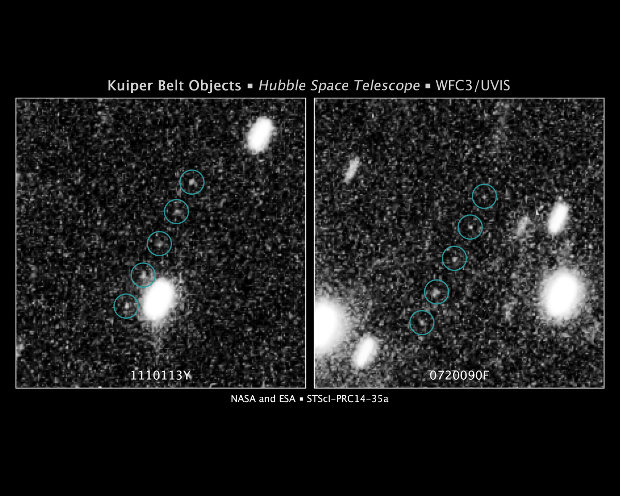
Despite being more than 24 years old, the Hubble Space Telescope keeps on proving it’s a truly remarkable instrument. In June, a test of observations was performed to search for celestial bodies in the Kuiper Belt, the region of the solar system beyond the orbits of the planets. This preliminary research has been a success because in the 20 areas observed for a total of 200 images two Kuiper Belt Objects (KBO) were found, two tiny planets, but their classification is to be determined, distant about 6.4 billion kilometers (about 4 billion miles) from Earth.
This search started because of the need to find a new target for the New Horizons space probe. At the moment, it’s heading towards Pluto for its primary mission of observation of this dwarf planet and its satellites. New Horizons will fly within 10,000 kilometers (about 6,200 miles) of Pluto in July 2015 but subsequently is expected to head to a Kuiper Belt Object. The problem is that the target is still to be determined but should be decided well in advance to schedule the New Horizons’ maneuvers.
NASA decided to use the Hubble Space Telescope to scan the Kuiper Belt in search for an interesting target and the first results are indeed interesting. Hubble’s sharp vision and unique sensitivity allowed to identify two very dim objects as they moved. Various ground telescopes have been used to look for that kind of objects over time but with no success.
The team that carried out the preliminary research used various image analysis programs to help them find the two objects, for now called just 1110113Y and 0720090F. Those are software for image analysis and comparison that help finding moving objects.
This initial success led to the approval of a broader search. In the Kuiper Belt there may be many other dwarf planets so the Hubble Space Telescope could find some of them. This will allow the team that runs the New Horizons mission to set a target for the probe. In autumn 2015, the spacecraft’s route will be changed to send it to its new target, which will be reached after three or four years. It will be the most distant celestial body ever studied closely.
[ad name=”eBayUSUKAstronomy”]


Permalink